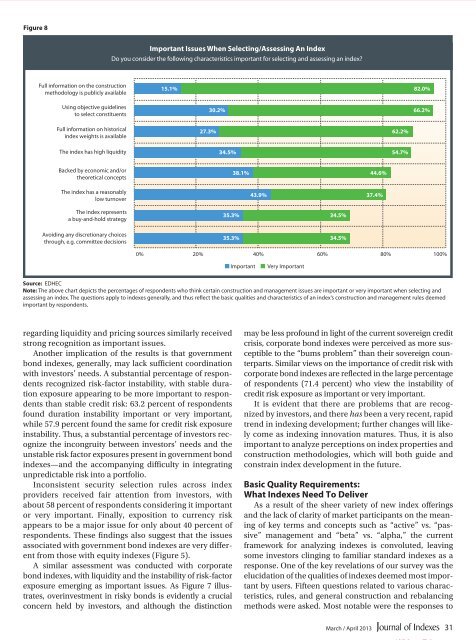Download complete issue - IndexUniverse.com
Download complete issue - IndexUniverse.com
Download complete issue - IndexUniverse.com
You also want an ePaper? Increase the reach of your titles
YUMPU automatically turns print PDFs into web optimized ePapers that Google loves.
Figure 8<br />
Important Issues When Selecting/Assessing An Index<br />
Do you consider the following characteristics important for selecting and assessing an index?<br />
Full information on the construction<br />
methodology is publicly available<br />
Using objective guidelines<br />
to select constituents<br />
15.1%<br />
82.0%<br />
30.2% 66.2%<br />
Full information on historical<br />
index weights is available<br />
27.3% 62.2%<br />
The index has high liquidity<br />
34.5%<br />
54.7%<br />
Backed by economic and/or<br />
theoretical concepts<br />
The index has a reasonably<br />
low turnover<br />
The index represents<br />
a buy-and-hold strategy<br />
38.1% 44.6%<br />
43.9% 37.4%<br />
35.3% 34.5%<br />
Avoiding any discretionary choices<br />
through, e.g. <strong>com</strong>mittee decisions<br />
35.3% 34.5%<br />
0% 20%<br />
40% 60% 80% 100%<br />
Important<br />
Very Important<br />
Source: EDHEC<br />
Note: The above chart depicts the percentages of respondents who think certain construction and management <strong>issue</strong>s are important or very important when selecting and<br />
assessing an index. The questions apply to indexes generally, and thus reflect the basic qualities and characteristics of an index’s construction and management rules deemed<br />
important by respondents.<br />
regarding liquidity and pricing sources similarly received<br />
strong recognition as important <strong>issue</strong>s.<br />
Another implication of the results is that government<br />
bond indexes, generally, may lack sufficient coordination<br />
with investors’ needs. A substantial percentage of respondents<br />
recognized risk-factor instability, with stable duration<br />
exposure appearing to be more important to respondents<br />
than stable credit risk: 63.2 percent of respondents<br />
found duration instability important or very important,<br />
while 57.9 percent found the same for credit risk exposure<br />
instability. Thus, a substantial percentage of investors recognize<br />
the incongruity between investors’ needs and the<br />
unstable risk factor exposures present in government bond<br />
indexes—and the ac<strong>com</strong>panying difficulty in integrating<br />
unpredictable risk into a portfolio.<br />
Inconsistent security selection rules across index<br />
providers received fair attention from investors, with<br />
about 58 percent of respondents considering it important<br />
or very important. Finally, exposition to currency risk<br />
appears to be a major <strong>issue</strong> for only about 40 percent of<br />
respondents. These findings also suggest that the <strong>issue</strong>s<br />
associated with government bond indexes are very different<br />
from those with equity indexes (Figure 5).<br />
A similar assessment was conducted with corporate<br />
bond indexes, with liquidity and the instability of risk-factor<br />
exposure emerging as important <strong>issue</strong>s. As Figure 7 illustrates,<br />
overinvestment in risky bonds is evidently a crucial<br />
concern held by investors, and although the distinction<br />
may be less profound in light of the current sovereign credit<br />
crisis, corporate bond indexes were perceived as more susceptible<br />
to the “bums problem” than their sovereign counterparts.<br />
Similar views on the importance of credit risk with<br />
corporate bond indexes are reflected in the large percentage<br />
of respondents (71.4 percent) who view the instability of<br />
credit risk exposure as important or very important.<br />
It is evident that there are problems that are recognized<br />
by investors, and there has been a very recent, rapid<br />
trend in indexing development; further changes will likely<br />
<strong>com</strong>e as indexing innovation matures. Thus, it is also<br />
important to analyze perceptions on index properties and<br />
construction methodologies, which will both guide and<br />
constrain index development in the future.<br />
Basic Quality Requirements:<br />
What Indexes Need To Deliver<br />
As a result of the sheer variety of new index offerings<br />
and the lack of clarity of market participants on the meaning<br />
of key terms and concepts such as “active” vs. “passive”<br />
management and “beta” vs. “alpha,” the current<br />
framework for analyzing indexes is convoluted, leaving<br />
some investors clinging to familiar standard indexes as a<br />
response. One of the key revelations of our survey was the<br />
elucidation of the qualities of indexes deemed most important<br />
by users. Fifteen questions related to various characteristics,<br />
rules, and general construction and rebalancing<br />
methods were asked. Most notable were the responses to<br />
March / April 2013<br />
31
















